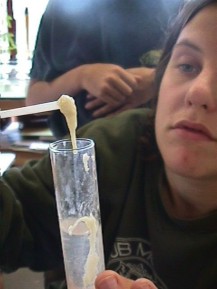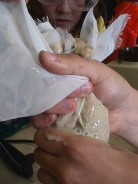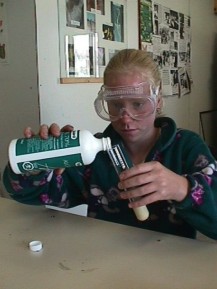

All life on earth shares a common beginning: the molecule DNA (DeoxyriboNucleic Acid). Understanding the nature and chemistry of this "molecule of life" promises to increase our knowledge of the origins of life and our ability to combat diseases and disabilities.
DNA exists in the cells of all living things. Simple prokaryotic cells, such as bacteria, have their DNA coiled openly inside the cell. Eukaryotic cells have nuclei, the DNA is coiled tightly inside the nucleus of each cell. Human cells are eukaryotic.
Extracting DNA from a sample involves breaking open the cell wall, then
the nucleus (if present) and finally creating the conditions that will
allow the strands of DNA to intertwine into an observable mass.
Getting There
Using information from various sources we tried unsuccessfully to extract DNA from a variety of plant materials - onions, beans, peas and wheat germ. Finally after much perseverance and experimenting, we found a method that worked using common materials. Heidi Robinson, our biology counselor, developed the method described here - the Heidi Protocol for DNA extraction.
The Heidi Protocol for DNA Extraction
Materials:
1 - Dissolve 2 tablespoons of salt in 500 ml of hot (45 Celsius) water.
2 - Pour 1/2 cup of wheat germ into the blender.
3 - Pour 250 ml of the salt/water solution into the blender.
4 - Blend the mixture for 10 seconds. (Use "blend" setting, no more then 10 seconds)
5 - Place the cheese cloth over the plastic tub. Secure the cloth with clothespins. The cloth should form a "well" inside the container.
6 - Pour some of the blended mixture into the well - do not over fill.
7 - With a large spoon, carefully press the mixture against the sides of the cloth. The liquid that collects in the plastic tub is the part we want. Collect as much liquid as possible.

If it is difficult to force the liquid through
the cloth, remove the "bag" of blended
material and squeeze with your hands.
8 - Add 1/4 teaspoon of dish washing detergent to the liquid in the container. Gently mix the detergent into the liquid. Do not introduce any bubbles into the mixture.

9 - Add a small amount of this
solution to each test tube. (1/3 test tube)

10 - Gently pour a similar quantity of
isopropyl alcohol into each test tube.
Do not shake the tube.

The DNA should float into the top half
of the mixture within a few minutes. It will
be cream coloured and will have bubbles in it.
You should be able to "spool" the DNA
onto a straw and remove it from solution.
Background
Wheat germ is the plant embryo part of a wheat seed.
The DNA in wheat germ is located inside the nucleus of each cell.
Blending the Wheat germ physically separates the cells, and breaks the cell walls , exposing the nucleus.
The membrane, or wall, of the nucleus is composed of lipids (fats). The molecular structure of soap allows it to mix with the fats of the nuclear wall, disrupting this membrane and allowing the DNA to float out into solution.
DNA is negatively charged, the individual molecules repel one another. Salt provides positive ions which neutralize the negative charge of the DNA allowing the long molecules to condense into a gelatinous mass.
DNA is less dense then water and the cell debris, this difference in density allows the DNA to float into the Isopropyl alcohol layer at the top of the test tube.